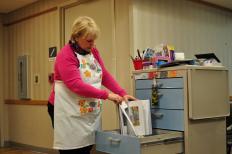






This is the second piece in a three-part series exploring the healing role of art in local hospitals. Read part one here.
 Sarah PettoSarah Petto’s art cart is always full of project ideas: origami, watercolor, and fiber art, among others. Petto pulls the cart next to the beds and chairs of patients to help them make hands-on art.
Sarah PettoSarah Petto’s art cart is always full of project ideas: origami, watercolor, and fiber art, among others. Petto pulls the cart next to the beds and chairs of patients to help them make hands-on art.“They are on a journey through art material,” said Petto.
As the artist-in-residence for UW Hospital and Clinics, Petto defines her role as a “facilitator,” rather than “teacher” or “doctor.” She provides art materials to the patients and helps them discover and create art.
“Express yourself,” Petto tells patients. “This is a stress free zone. There is no test at the end.”
As a former art teacher, Petto has a diverse range of art skills to offer to the patients. They make jewelry, paint on pumpkins, and reform old books.
For those patients who have lost hand dexterity, Petto prepares a mouth stick, to which a paintbrush or pencil can be attached. Petto and Jeremy Amble, a patient mentor in the hospital, also launched a photography session for visitors.
Now Petto’s efforts benefit from new technologies, like iPads, on which patients can play music and paint without spilling watercolors around the wards.
Seeking grants for the art program, however, is not easy task. It is hard to convince people that adults, like children, can benefit from making art, said Petto.
But Petto is constantly encouraged by the patients’ response. She still remembers clearly a cancer patient looking forward to making art and wondering what to do, “like a child going to school,” she said.
Patients turned artists, “have a new way to describe themselves,” said Petto.
Instead of talking about their physical condition and treatment to visitors, now patients can bring up a new and cheering topic -- their latest artwork.
“You are passive. You are being worked on when you are receiving chemo [therapy] and when you are being told what to do in rehab,” she said.
Petto believes that making art helps people “take an active role” during their healing process and “take some control.”
|
|
|
Welcome to the Madison Commons, a website designed to provide news and information about all of Madison's neighborhoods and a crossroads for the discussion of community issues. The name comes from the idea of a village commons, a place for news, talk, debate, and some entertainment, too, that's open to everyone.
All rights reserved. Read more about the Madison Commons and its partners.

